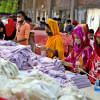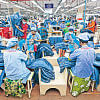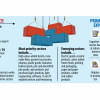Focus more on man-made fibre-based garment exports: PwC study

Bangladesh should expedite the making of garments from man-made fibre (MMF) as it will account for 60 percent of the value of globally traded garments items in 2030 compared to 50 percent in 2022, according to a study.
By 2030, the global export of garments will grow to $1,121 billion from $953 billion in 2022, said a study by Price Waterhouse Cooper (PwC). MMF and MMF-rich garments will account for 60 percent of that, while 35 percent will be cotton and cotton-rich items and only 5 percent will be others.
PwC shared the findings of the study, titled 'From shirts to shores: Blueprint for Bangladesh RMG Industry', at a press conference held at the Bangladesh Garment Manufacturers and Exporters Association (BGMEA) office in Dhaka.
PwC conducted the study on behalf of the BGMEA as it has set a target for Bangladesh to export $100 billion worth of apparel by 2030.
The study found that the total export value of garment items was $794 billion in 2013. MMF and MMF-rich items accounted for 46 percent of that while 40 percent was cotton and cotton-rich and others contributed 14 percent.
In 2022, the value of globally traded garment items stood at $953 billion, with 50 percent MMF and MMF-rich, 37 percent cotton and cotton-rich and 13 percent were others, the study said.
Of the total exported value of MMF and MMF-rich garment items in 2022, some $320 billion was captured by China and $41 billion was exported by Vietnam.
Italy accounted for 39 billion while Turkey also held a major percentage, the data showed.
The study also found that the total global trade of four garment items, including brassieres, technical garments, activewear and swimwear, and jackets, suits and blazers, stood at $100 billion. Around 73 percent of that value came from MMF-based items.
However, Bangladesh only has a 6 percent share in the $14 billion global market for brassieres and a 5.4 percent share of the $16.6 billion technical garment items segment.
The global market value of MMF and MMF-rich activewear and swimwear is $30.5 billion, of which Bangladesh's share is 4.3 percent. In the case of jackets/suits/blazers, the global market value is $32.2 billion and Bangladesh's share in this segment is 2.5 percent, the study said.
The study added that Bangladesh needed to develop the ecosystem to become more competitive in the manufacturing of select products. It also stressed to need to position Bangladesh as supplier of value-added MMF-based products for the EU, US and UK, and make continuous efforts to penetrate new markets, including Japan and South Korea.
Demand for recycled fashion will also increase globally in the coming years and Bangladesh should also focus more on manufacturing those items, the study said, adding that 577,000 tonnes of garment waste is generated in Bangladesh and only 5 percent is recycled locally.
Outgoing BGMEA President Faruque Hassan said that in order to reach the $100 billion export target by 2030, services offered by the customs, ports and bond should be improved significantly.
Bangladesh's graduation from least developed country (LDC) status in 2026 poses a major challenge to garment exports because of the erosion of the preferences, Hassan said, adding that the issue needs to be addressed properly so exports remain unhurt afterwards.
The BGMEA chief also said new markets have been showing great promise. For instance, garment exports to new destinations over the past 14 years increased 10-fold to $8.37 billion from $849 million.
Included in the list of promising new destinations are India, Japan, China, South Korea, Australia, Russia, Saudi Arabia, the UAE, and Turkey.
The value addition of garment items exported from Bangladesh also reached 71.35 percent in the October-December period of the current fiscal year as garment exporters significantly reduced dependence on imported raw materials, Hassan added.
The PwC study recommended an investor-friendly framework to avail external commercial debt and foreign direct investment alongside a time-bound approval process.
For external borrowings, greater clarity on tenor, pricing, security structure, permissible end-use, eligible lenders, and an automatic clearance mechanism for identified projects can facilitate higher flow of financing.

 For all latest news, follow The Daily Star's Google News channel.
For all latest news, follow The Daily Star's Google News channel. 









Comments